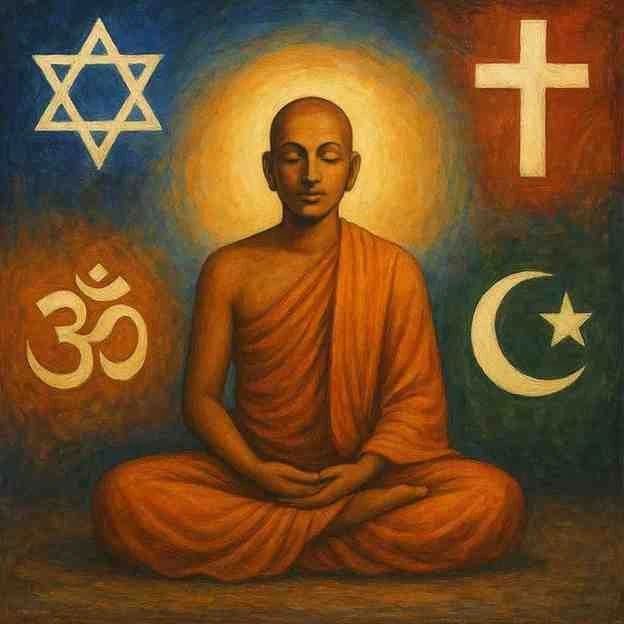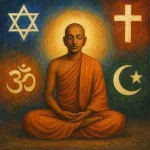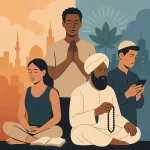Meditation as the Common Ground for All Religions
Across cultures and centuries, humanity has searched for ways to connect with the divine. While languages, rituals, and doctrines differ, one practice quietly unites almost every spiritual tradition — meditation. From the stillness of Buddhist monks to the deep prayer of Christian mystics, from the chanting of Hindu sages to the silent reflection of Sufi saints, meditation stands as a universal bridge between faiths. It is where religion transcends boundaries, and spirituality becomes a shared human experience.
The Universal Language of Stillness
Meditation, at its heart, is the art of stillness — of turning inward to find truth, peace, and divine connection. Long before organized religions existed, early humans sat in silence, contemplating the mysteries of life and nature. This simple act evolved into structured spiritual practices across civilizations.
In Hinduism, meditation (dhyana) is one of the eight limbs of yoga — a means to achieve self-realization. In Buddhism, mindfulness and insight meditation lead to enlightenment. Christian saints practiced contemplative prayer, seeking unity with God through silence. In Islam, Sufis meditate through zikr, the rhythmic remembrance of God’s name. Even in Judaism, the Kabbalistic tradition includes meditative reflection to understand divine wisdom.
Though their forms differ, the essence is the same: calming the mind, opening the heart, and aligning the soul with a higher presence.
Meditation Beyond Ritual and Religion
One of the reasons meditation transcends all religions is that it speaks to something universal within us — consciousness. While rituals and scriptures may vary, human awareness is the same everywhere. Meditation helps individuals experience that shared inner reality.
In silence, there are no divisions — no “Hindu” or “Christian,” no “Muslim” or “Buddhist.” There is only awareness. It is in this sacred space that humanity realizes its oneness. Many spiritual teachers across traditions have emphasized that the divine cannot be found outside until it is first discovered within. Meditation becomes the bridge that takes us inward, beyond labels and dogmas.
Science Rediscovers an Ancient Truth
Modern science has begun to confirm what ancient mystics knew: meditation changes the brain and the body in profound ways. Neurologists have found that regular meditation enhances focus, emotional stability, and compassion. It reduces stress, lowers blood pressure, and improves mental clarity.
Brain scans show that during deep meditation, the regions linked with self-centered thinking become less active, while areas connected with empathy and awareness become more alive. These findings echo spiritual truths — that meditation dissolves the ego and reveals the interconnectedness of all life.
Thus, what began as a religious practice has now become a universal wellness tool. Millions around the world, regardless of faith, practice meditation for inner peace and balance. Science has not replaced spirituality — it has simply helped validate its timeless wisdom.
Meditation as Prayer in Silence
Every religion teaches prayer — but meditation is often seen as the silent dimension of prayer. When words end, meditation begins. Prayer is speaking to God; meditation is listening. Together, they form a complete conversation between the human and the divine.
In Christianity, contemplative prayer leads the seeker into “the silence of God.” In Sufism, deep zikr brings the heart into rhythmic harmony with the divine pulse. In Hindu and Buddhist traditions, meditation quiets the mind so that truth can be directly experienced. These experiences are not bound by theology — they are felt universally as peace, light, and love.
A Tool for Harmony and Peace
In a world often divided by religion, meditation offers a pathway to unity. When individuals from different faiths sit together in silence, something remarkable happens — their differences fade. They experience the same stillness, the same breath, the same inner calm. This shared silence becomes a form of interfaith dialogue that needs no words.
Many global peace movements and spiritual communities now use meditation as a medium for harmony. Schools, workplaces, and even governments are incorporating it to cultivate compassion and emotional intelligence. The more people meditate, the more peaceful their minds become — and the more peaceful our world can be.
The Inner Revolution
Meditation is not just a relaxation technique; it is a revolution of awareness. It shifts attention from the outer world of noise and competition to the inner world of stillness and understanding. When practiced regularly, meditation transforms character — reducing anger, greed, and fear. It awakens empathy and patience, qualities that all religions cherish.
This inner transformation is the true goal of every faith. Rituals, scriptures, and traditions are paths — meditation is the essence that unites them. It brings the divine out of temples and into the heart, reminding humanity that heaven is not somewhere else — it begins within.
The Shared Path to the Divine
In the end, meditation reveals what every religion has always tried to teach — that we are not separate from the divine or from one another. It strips away the outer differences and leads to the universal truth of oneness.
Whether one calls it dhyana, prayer, zikr, or mindfulness, meditation is humanity’s shared sacred language. It reminds us that beneath the surface of names and symbols, all faiths seek the same destination — peace, love, and union with the Source.
In the silence of meditation, religions meet, and humanity becomes one. It is here, in this stillness, that the divine smiles — not as many gods of many names, but as one infinite presence reflected in every heart.
~Religion World Bureau









